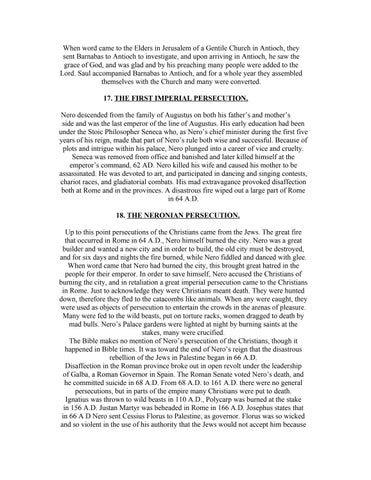When word came to the Elders in Jerusalem of a Gentile Church in Antioch, they sent Barnabas to Antioch to investigate, and upon arriving in Antioch, he saw the grace of God, and was glad and by his preaching many people were added to the Lord. Saul accompanied Barnabas to Antioch, and for a whole year they assembled themselves with the Church and many were converted. 17. THE FIRST IMPERIAL PERSECUTION. Nero descended from the family of Augustus on both his father’s and mother’s side and was the last emperor of the line of Augustus. His early education had been under the Stoic Philosopher Seneca who, as Nero’s chief minister during the first five years of his reign, made that part of Nero’s rule both wise and successful. Because of plots and intrigue within his palace, Nero plunged into a career of vice and cruelty. Seneca was removed from office and banished and later killed himself at the emperor’s command, 62 AD. Nero killed his wife and caused his mother to be assassinated. He was devoted to art, and participated in dancing and singing contests, chariot races, and gladiatorial combats. His mad extravagance provoked disaffection both at Rome and in the provinces. A disastrous fire wiped out a large part of Rome in 64 A.D. 18. THE NERONIAN PERSECUTION. Up to this point persecutions of the Christians came from the Jews. The great fire that occurred in Rome in 64 A.D., Nero himself burned the city. Nero was a great builder and wanted a new city and in order to build, the old city must be destroyed, and for six days and nights the fire burned, while Nero fiddled and danced with glee. When word came that Nero had burned the city, this brought great hatred in the people for their emperor. In order to save himself, Nero accused the Christians of burning the city, and in retaliation a great imperial persecution came to the Christians in Rome. Just to acknowledge they were Christians meant death. They were hunted down, therefore they fled to the catacombs like animals. When any were caught, they were used as objects of persecution to entertain the crowds in the arenas of pleasure. Many were fed to the wild beasts, put on torture racks, women dragged to death by mad bulls. Nero’s Palace gardens were lighted at night by burning saints at the stakes, many were crucified. The Bible makes no mention of Nero’s persecution of the Christians, though it happened in Bible times. It was toward the end of Nero’s reign that the disastrous rebellion of the Jews in Palestine began in 66 A.D. Disaffection in the Roman province broke out in open revolt under the leadership of Galba, a Roman Governor in Spain. The Roman Senate voted Nero’s death, and he committed suicide in 68 A.D. From 68 A.D. to 161 A.D. there were no general persecutions, but in parts of the empire many Christians were put to death. Ignatius was thrown to wild beasts in 110 A.D., Polycarp was burned at the stake in 156 A.D. Justan Martyr was beheaded in Rome in 166 A.D. Josephus states that in 66 A D Nero sent Cessius Florus to Palestine, as governor. Florus was so wicked and so violent in the use of his authority that the Jews would not accept him because
Issuu converts static files into: digital portfolios, online yearbooks, online catalogs, digital photo albums and more. Sign up and create your flipbook.

